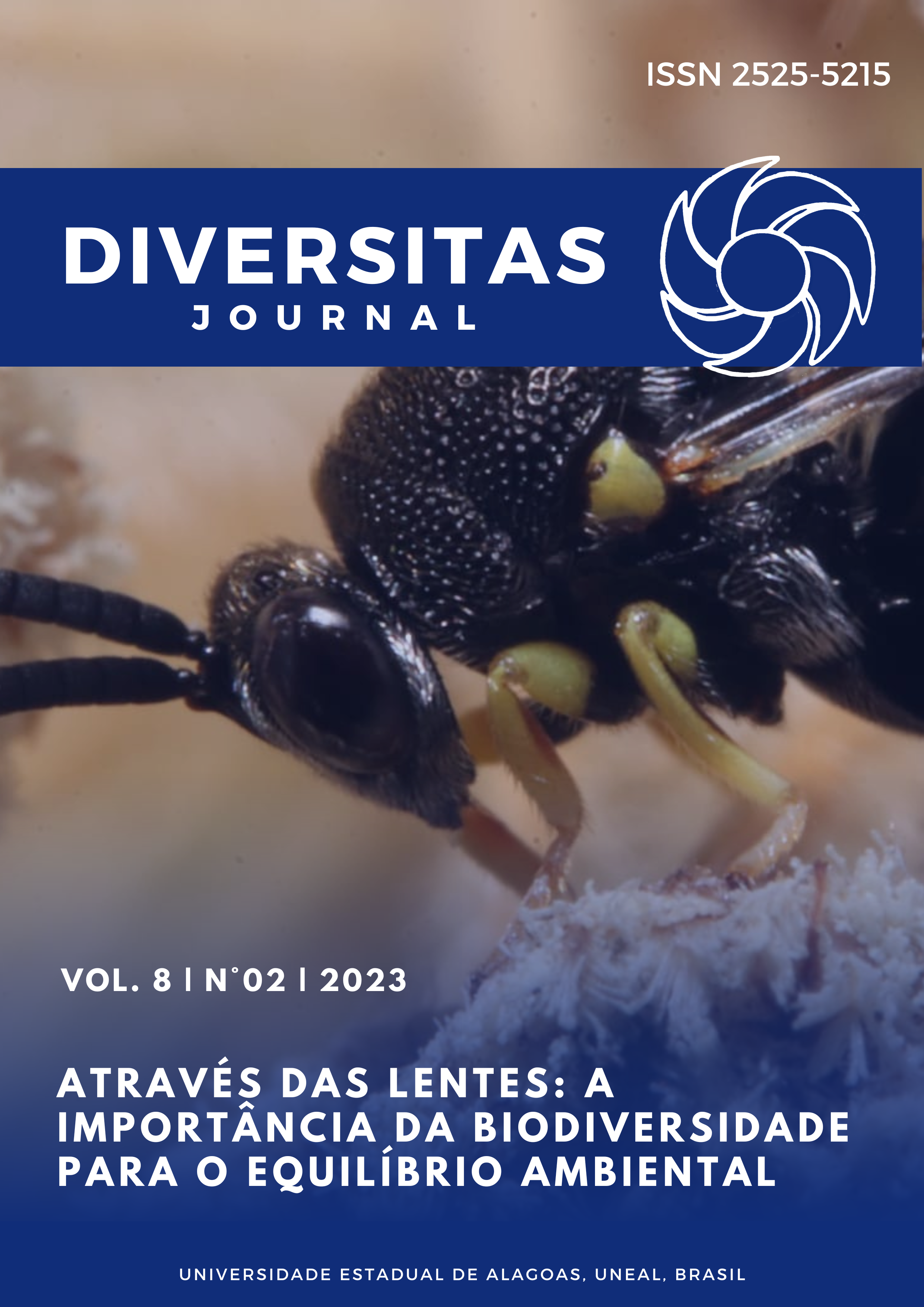Higher education students perception of the importance of exsiccata for plant taxonomic identification
DOI:
https://doi.org/10.48017/dj.v8i2.2461Keywords:
Teaching of Botany, Taxonomy, AmazonasAbstract
The teaching of Botany, in turn, takes place in a disjointed way and without contextualization, in an approach that makes it difficult to properly learn its concepts. With this, the present work aimed to recognize the importance of botanical collections in the teaching of plant taxonomy for undergraduate students in Science: Biology and Chemistry at the Federal University of Amazonas - UFAM. The research was carried out at the Instituto de Natureza e Cultura–INC/UFAM in the municipality of Benjamin Constant - AM, and a questionnaire was prepared and applied to 20 students from the 6th period addressing popular knowledge with scientific knowledge and the importance of identifying plant species. Through the results obtained, it was found that the questionnaires had a positive return on the students' knowledge about the techniques of exsiccata, since all the students knew how to answer the concept and the necessary scientific methodological procedures. However, only 75% of students are aware of the storage of exsiccates present in the educational institution, showing that there are still students who are unaware of this extremely important scope in the specific area of Botany. It is worth mentioning that the students mentioned that the exsiccata or plant samples are of great importance, since this serves as an identification of plants or species and from the exsiccata it is possible to carry out scientific work or even compare them with other plant species. Therefore, this research is of fundamental importance for a better understanding of the exsiccata and botanical identification in the current context that the university finds itself, in the triple border Brazil x Peru x Colombia, rethinking the way of approaching the botany content, so that the student is interested for the same and does not perpetuate the “botanical blindness”, enabling the perception of the importance of plants in their daily lives.
Metrics
References
Alves, L. C., Lima, R. A. (2022). Bingo Celular: O lúdico no processo de ensino e aprendizagem. Diversitas Journal, 7(4), 2870-2979. 2022. https://diversitasjournal.com.br/diversitas_journal/article/view/2315/1798
Cavalcante, F. S., Freitas, J. F., Couto, C. A., Tavares, G. S. B., Nogueira, P. G., Lima, R. A. (2018). DNA vegetal na sala de aula: o ensino-aprendizagem em botânica. RECH - Revista Ensino de Ciências e Humanidades - Cidadania, Diversidade e Bem-Estar, 1(1), 176-191. 2018. https://periodicos.ufam.edu.br/index.php/rech/article/view/4762
Faria, M. T., Vilhalva, D. A. (2016). Importância das aulas práticas na disciplina de anatomia Vegetal: descrição da anatomia foliar e histoquímica de Plectranthus barbatus Andrews (Lamiaceae). Revista Eletrônica de Educação da Faculdade UniAraguaia, 10(10), 214-223. 2016. https://www.fara.edu.br/sipe/index.php/REVISTAUNIARAGUAIA/article/view/465
Krasilchik, M. (2004). Prática de ensino de Biologia. (4ª ed). São Paulo: EDUSP.
Krasilchik, M. (2008). Prática de Ensino de Biologia. São Paulo: EDUSP.
Lima, R. A., Saldanha, L. S., Cavalcante, F. S., Pinto, M. N., Moura, O. S. (2020). O estudo das briófitas numa escola pública de Humaitá. Revista Educamazônia, 24(1), 218-232. 2020. https://periodicos.ufam.edu.br/index.php/educamazonia/article/view/7675
Lucas, F. C. A., Lobato, G. J. M., Leão, V. M., Mesquita, U. O., Santos, S. F. (2017). Ressignificação das aulas de botânica na escola: sensibilização e valorização da biodiversidade amazônica. Revista Espacios, 38(35), 21-35. 2017. https://www.revistaespacios.com/a17v38n35/a17v38n35p21.pdf
Melo, E. A., Abreu, F. F., Andrade, A. B., Araújo, M. I. O. (2012). A aprendizagem de botânica no ensino fundamental: dificuldades e desafios. Scientia Plena, 8(10), 1-8. 2012. https://www.scientiaplena.org.br/sp/article/view/492/575
Monteiro, S. S., Siani, A. C. (2013). A Conservação de Exsicatas em Herbários: Contribuição ao Manejo e Preservação. Revista Fitos, 4(2), 24-37. 2013. https://revistafitos.far.fiocruz.br/index.php/revista-fitos/article/view/95
Moura, O. S., Gonçalves, J. S., Lima, R. A., Gorod, J. D., Gonçalves, J. M. (2021). Herbário COOE: importância como ferramenta de estudo e conservação da biodiversidade vegetal de Rondônia. Revista Educamazônia, 8(1), 183-199. 2021. https://www.periodicos.ufam.edu.br/index.php/educamazonia/article/view/8411
Neves, A., Bündchen, M., Lisboa, C. P. (2019). Cegueira botânica: é possível superá-la a partir da Educação? Ciência & Educação, 25(3), 745-762. 2019. https://www.scielo.br/j/ciedu/a/xQNBfh3N6bdZ6JKfyGyCffQ/?format=pdf&lang=pt
Paes, L. S., Lima, D. C. F., Marques, J. D. O., Azevedo, R. O. M., Barbosa, T. J. V. B. (2015). Atividades didáticas para o ensino da classificação das plantas no sétimo ano do ensino fundamental. Investigação Qualitativa em Educação, 2(1), 123-128. 2015. https://proceedings.ciaiq.org/index.php/ciaiq2015/article/view/228/224
Peixoto, A. L., Morim, M. P. (2003). Coleções botânicas: documentação da biodiversidade brasileira. Ciência & Cultura, 55(3), 21-24. 2003. http://cienciaecultura.bvs.br/scielo.php?script=sci_arttext&pid=S0009-67252003000300016
Salantino, A., Buckeridge, M. (2016). Mas de que te serve saber botânica? Estudos Avançados, 30(87), 177-196. 2016. https://www.revistas.usp.br/eav/article/view/119122
Silva, J. R., Almeida, W. A., Lima, R. A. (2019). Biomas brasileiros: um jogo educativo para o ensino fundamental em uma escola pública no Alto Solimões. South American Journal of Basic Education, Technical and Technological, 6(1), 408-417. 2019. https://periodicos.ufac.br/index.php/SAJEBTT/article/view/2338/1578
Souza, H. N., Lima, R. A. (2021). Um estudo da cegueira botânica nos livros didáticos do ensino médio em escolas públicas de Humaitá-AM, Brasil. Revista Educamazônia, 15(2), 31-45. 2021. https://periodicos.ufam.edu.br/index.php/educamazonia/article/view/10195
Downloads
Published
How to Cite
Issue
Section
License
Copyright (c) 2023 Igor Tourinho dos Santos, Carlos Cavalcante de Oliveira, Alexander da Silva Patrício, Margred de Lima Ramos, Renato Abreu Lima

This work is licensed under a Creative Commons Attribution 4.0 International License.
The Diversitas Journal expresses that the articles are the sole responsibility of the Authors, who are familiar with Brazilian and international legislation.
Articles are peer-reviewed and care should be taken to warn of the possible incidence of plagiarism. However, plagiarism is an indisputable action by the authors.
The violation of copyright is a crime, provided for in article 184 of the Brazilian Penal Code: “Art. 184 Violating copyright and related rights: Penalty - detention, from 3 (three) months to 1 (one) year, or fine. § 1 If the violation consists of total or partial reproduction, for the purpose of direct or indirect profit, by any means or process, of intellectual work, interpretation, performance or phonogram, without the express authorization of the author, the performer, the producer , as the case may be, or whoever represents them: Penalty - imprisonment, from 2 (two) to 4 (four) years, and a fine. ”


















